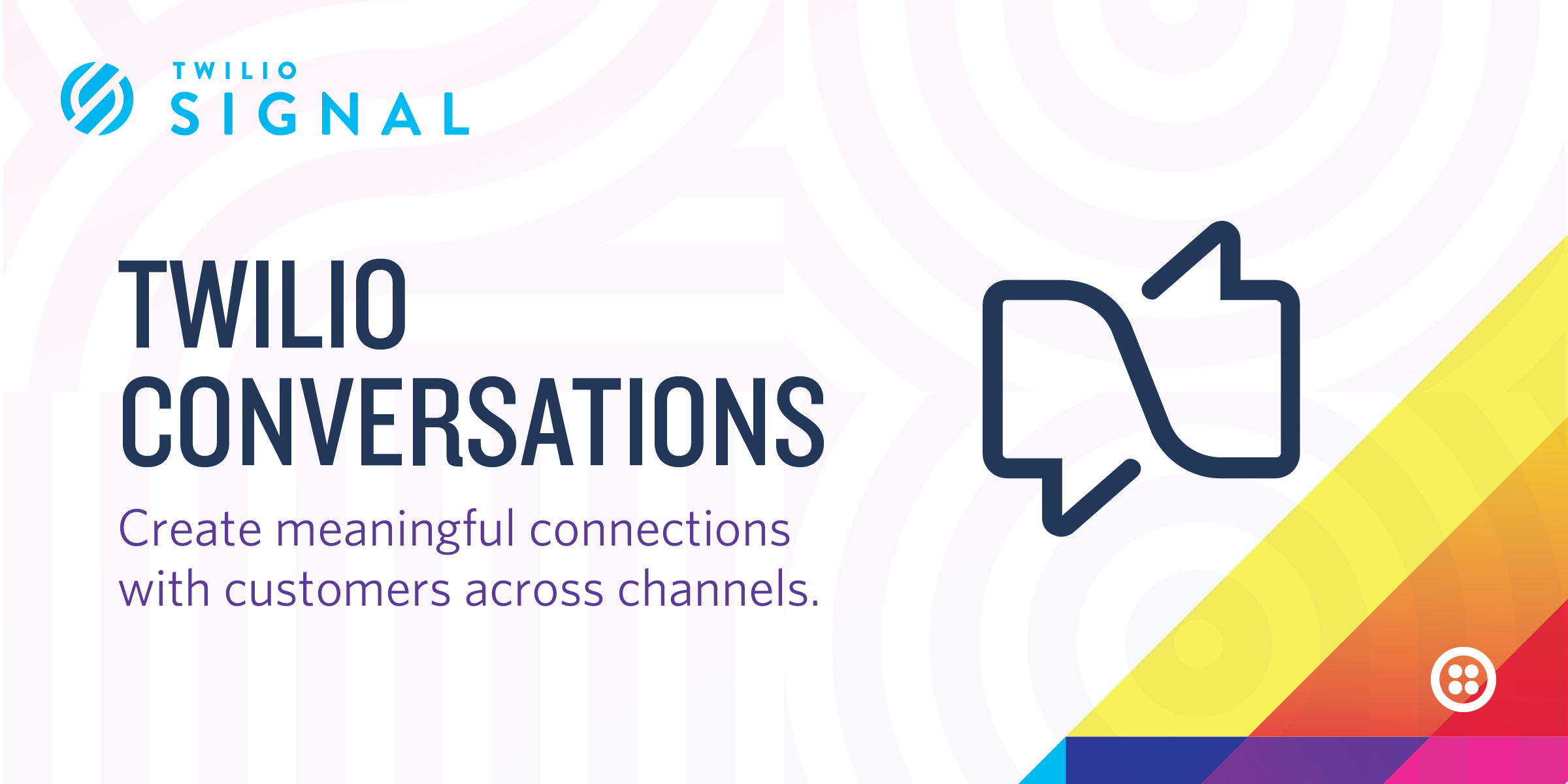Introducing Twilio Conversations: Now, every message becomes an invitation for a conversation
Time to read: 4 minutes

With Twilio Conversations, every business can use cross-channel conversations to build long-lasting customer relationships. Building on the same messaging platform that has allowed digital natives and major enterprises to build communications into their applications, Twilio Conversations is a unified API that solves some of the greatest challenges in customer messaging: cross-channel orchestration, participant management, and message archives.
Why Twilio Conversations?
More businesses than ever are turning to messaging through SMS, WhatsApp, and chat to answer routine questions, deliver up-to-date notifications, or keep customers informed of an upcoming promotion. For many businesses, however, it’s still new terrain. What makes some businesses embrace two-way conversational messaging while others simply send one-way notifications or rely on phone calls or email alone?
Channels
For starters, channel preferences vary. In some regions SMS is the dominant channel; in others, the only way to guarantee a message gets through is over WhatsApp. Customers expectations are shifting and they’re increasingly looking for businesses to be as accessible as a friend or family member. For many businesses, in-app or browser-based chat is the preferred channel for fielding support requests and other consumer communications. And, for businesses with distributed workforces, it might be easier for employees to text while in the field.
Twilio Conversations supports any combination of web or in-app chat, SMS, MMS, and WhatsApp to ensure businesses and customers are all speaking the same language, on their preferred platform.
Group and conversation management
If you’ve ever been involved in a one-sided conversation, you know how tiring it becomes. The best conversations involve multiple participants, and that’s true for conversations with businesses, too! Many developers have already implemented SMS to chat conversations, but what happens when customers are traveling, or when you need to add additional participants or support cross-channel media? Sometimes the unknown is enough to keep you from building at all.
With the increased demand for conversational messaging, businesses are also faced with the challenge of introducing new channels and moderating content sent over those channels for compliance purposes. In some cases, customers and employees have turned to messaging on their personal devices which not only creates privacy and compliance concerns, but prevents you from having full insight into your customer engagement. Twilio Conversations gives you programmatic control over participant management for each conversation, allowing users to be added or removed. Now conversations can expand to include specialists, support teams, or family members of customers. And conversation logging allows you to retain message archives for as long as you need enabling businesses to leverage that data to better understand their customers.
Faster time-to-market
We’re constantly learning from the more than 6M developers on the Twilio platform – and we’ve learned from developers who built conversational messaging applications. That’s why we built Twilio Conversations. Rather than spend the time to build on each channel primitive and having to implement channel orchestration, groups management, and message archives, that functionality is built-in. We estimate Twilio Conversations reduces development time from three-to-six months to three weeks.
How? We’ll show you!
Getting started with Twilio Conversations
A few calls to the Twilio Conversations REST API will create all the building blocks you need to start building. Your Twilio credentials are all you need to get started.
The main building block for Twilio Conversations is the Conversation resource that represents a unique thread of your conversation. There are also subresources like conversation participants, conversation messages, and conversation-scoped webhooks.
Here’s a quick look:
- Conversation Resource: Every Twilio Conversation starts with the conversation resource, representing a unique thread of a conversation including unique participants and messages sent between users.
- Conversation Participant Resource: Each participant in a Conversation is represented separately in the REST API, with their Chat Identity or WhatsApp number specified. Once you add a participant, messages are distributed automatically to them.
- Conversation Message Resource: From the REST API you can read, update, or add messages to a conversation programmatically. Any message in the conversation history will appear here, even if the participants have since changed.
- Conversation-Scoped Webhooks: Scoped webhooks are a way to attach a unique monitor, bot, or other integration to each conversation. For instance, you can use Twilio Studio integrations or Twilio Autopilot to listen in for keywords and escalate to a human. Each conversation supports up to five scoped webhooks.
Pricing
Conversations starts at $0.03 per active user/month during the public beta period. You will also be charged for underlying storage fees ($0.25/GB) and any associated SMS or WhatsApp costs.
Learn more about active users and pricing.
Turn every message into a conversation
With Twilio Conversations you don’t have to worry about losing out on opportunities to connect with customers – rather than spending time to build and maintain the complex infrastructure, you can turn every message into an invitation to continue the conversation.
Check out our Twilio Conversations quickstart in the Docs to get started. Every relationship begins with a connection; we’re excited to see how you use Twilio Conversations to build loyal customers!
Andres Jaan Tack is a four-year veteran at Twilio, and directs the Conversational Messaging product family. Before making the turn to product he was a lead engineer and built Twilio Sync, the high-performance underpinnings of Twilio Chat. Andres works in Twilio's Estonian office, and lives in Tallinn with his wife and two daughters.
Related Posts
Related Resources
Twilio Docs
From APIs to SDKs to sample apps
API reference documentation, SDKs, helper libraries, quickstarts, and tutorials for your language and platform.
Resource Center
The latest ebooks, industry reports, and webinars
Learn from customer engagement experts to improve your own communication.
Ahoy
Twilio's developer community hub
Best practices, code samples, and inspiration to build communications and digital engagement experiences.


